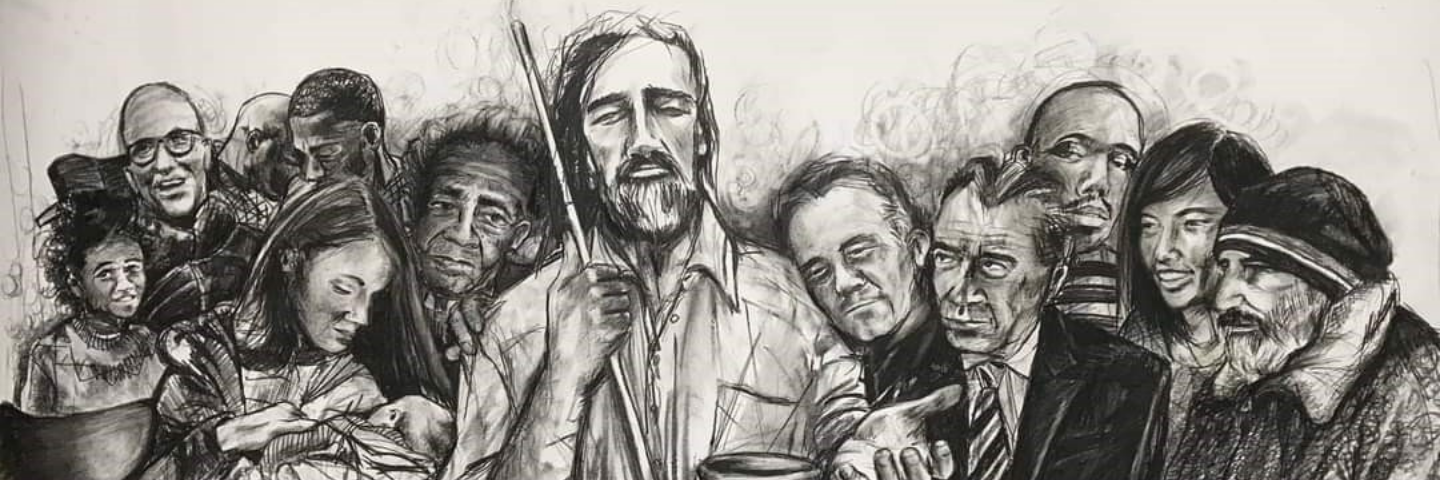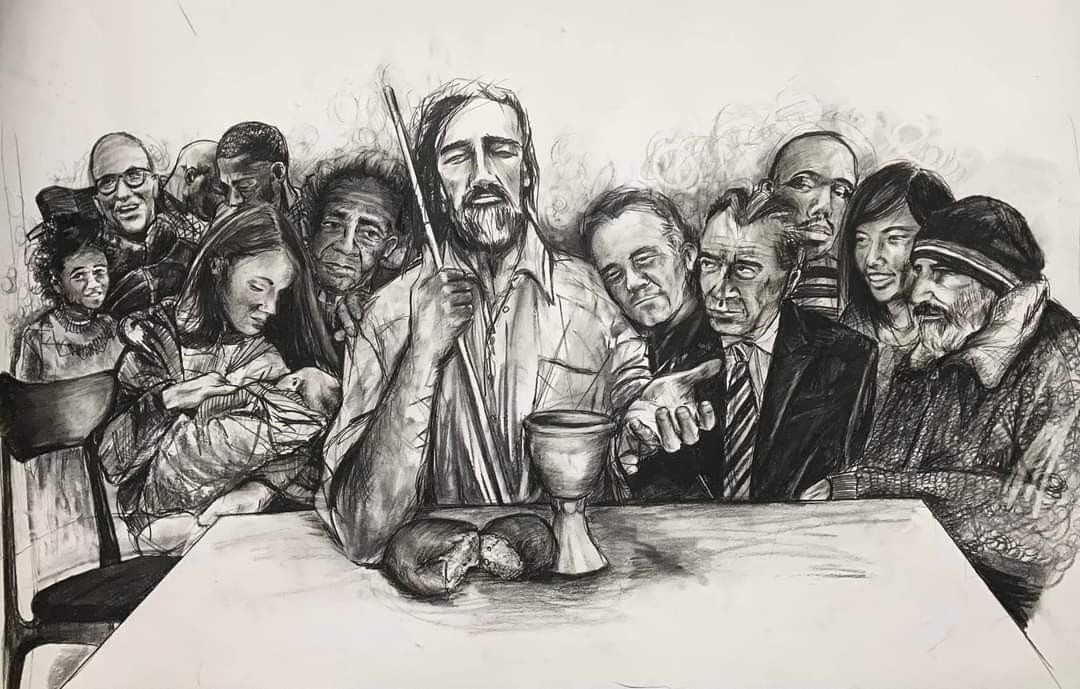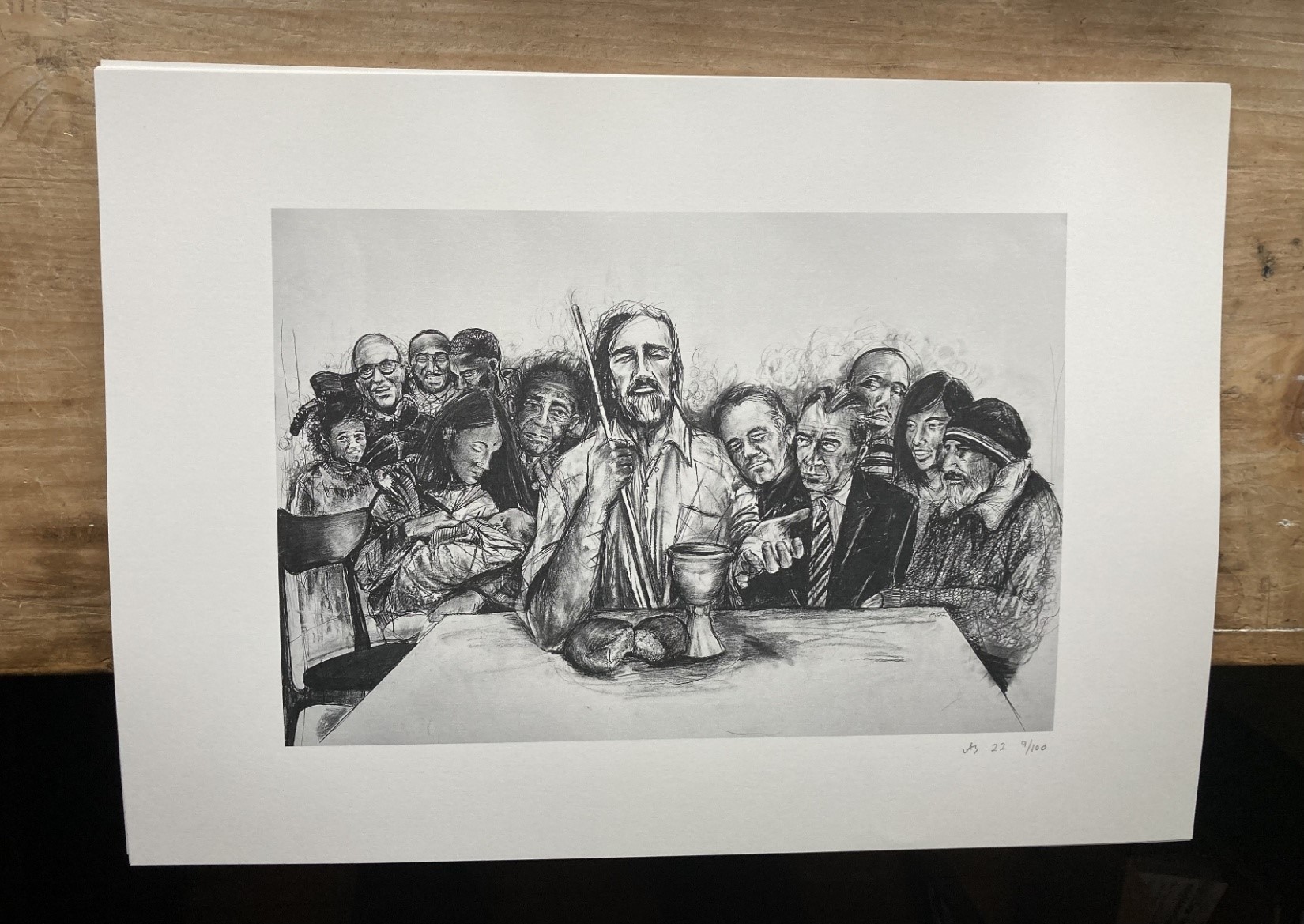 Blind Jesus (No one belongs here more than you)
Blind Jesus (No one belongs here more than you)
'This is a Jesus who comes from a place of vulnerability, unaffected by the visual appearance of others.'
April 2022
Rev. Alan Stewart tells the story behind his drawing based on the Last Supper
A few months ago, I was introduced to a lady called Celia Webster, a member of the Church of England Disability Group. For several years, Celia has had a vision for an image of the Last Supper where people of differing abilities are gathered at table with Jesus. Celia’s daughter was born with learning difficulties and as a family they have experienced first hand an intense feeling of not belonging inside and outside of church; of feeling rejected, invisible, misunderstood, vulnerable.
In conversation with Celia and a friend, Jonathan Evens, that vision evolved into this image.

It’s an image in charcoal which includes the central character of a visually impaired Jesus, surrounded by twelve people of differing ages, backgrounds and abilities.
The hope is that it will be a nomadic piece, travelling from place to place, and that prints will be made to support charity and that resources will be created for use in schools.
From left to right:
- an empty chair
- a little girl with curly hair and a big smile
- a middle-aged man (a friend of Celia) in a wheelchair
- a male same-sex couple
- a young woman breastfeeding a baby, who is, incidentally, one of the twelve
- an elderly woman with her hand on Jesus’ shoulder
- Jesus; a white stick resting against his body, his left hand outstretched, scars of self harm visible on his arms
- a young man with Down Syndrome resting on Jesus’ shoulder
- a middle-aged man in a suit
- a young man experimenting with his identity
- a young woman smiling
- an older man, a rough sleeper perhaps
This Jesus challenges theological and Biblical imagery that equate blindness to sin or as something to be cured of. For many visually impaired people, their blindness is an essential part of their identity, finding stories such as our first reading difficult or painful. This is a Jesus who comes from a place of vulnerability, unaffected by the visual appearance of others.
Responding to the image, a visually impaired friend has written: ‘An image of Jesus who is like me makes me feel accepted’ … ‘I wish my visual impairment would be cured. But I am glad that Jesus embraces it’.
Writing about the piece, John Beauchamp, the London Diocesan Disability Ministry Enabler, himself blind, says: ‘The depiction of Jesus as representing bodily perfection and physical ability has denied a vast swathe of humankind a direct connection with the notion of incarnation. The incarnation of the divine in human form has been restricted to a complete, healthy, fully functioning body and mind, and disabled people, whose bodies are incomplete or dysfunctional, whose senses do not interpret the world with clarity or focus, whose minds function differently and awkwardly, have been left in a marginal space.
‘Disconnected from the embodied Christ by their wounds and physical and mental impairments. Others have been excluded by the church; a church that has tried to own the embodied Christ and has attempted to limit who he is. The colour of your skin, the person you love, your background and origin. All these have been used to separate people from the embodied Christ and have pushed people into marginal spaces. But Jesus is the divine embodiment of all of humankind. Those who are blind and deaf. Those who bear the scars of their mental pain. Those whose bodies are incomplete or dysfunctional. Those who are black and brown and all the rich skin tones that grace the earth. Those who are LGBTQIA+ and seek to love with integrity and honesty. Those who are young and see the world through the innocent eyes of a child. Those who are old and see the world passing them by and feel unrecognised and unheard. Those whose genetic make-up destined them to possess a rare beauty and nature, but who are misunderstood and ostracised by a judgemental world. Those whose minds interpret the world in a way that others do not understand. Those who express themselves in ways that some find disturbing or frightening. Those whose feelings of shame and self-doubt haunt their lives and keep them in the shadows. This Jesus, this Christ, this Messiah, is all of these people and many more. The incarnation is not limited to bodily perfection, physical ability, or mental capacity, but embraces all that humankind has labelled as ‘other,’ as outside of God’s grace and love.
‘In this Last Supper, the marginalised and excluded and devalued are invited to the table. Invited to be with Jesus. To sit and eat with him. To find themselves with him and recognise themselves in him. To find that their embodiment is not a barrier but in fact their passport into the kingdom where all of our human diversity is redeemed and celebrated in a riot of joy and celebration.’
Ask yourself these questions...
What associations do we have with blindness?
How does this Jesus ‘see’ me?
Are we comfortable with a Jesus who self-harms?
Is his outstretched hand a welcome or is he asking for help?
I wonder why each ‘disciple’ has been chosen
I wonder if you’re uncomfortable with any of these guests and, if so, why?
Who else should be at this meal?
I wonder where you would put yourself in this picture?
Is the empty chair for you?
What title would you give this?
Christ says, ‘Come to me; the tired and the traumatised, the powerful and powerless, the helpful and the helpless… for here you will be welcomed, for no one belongs here more than you.’
(These words are from Rev. Alan's Sermon on Maundy Thursday, 14 April 2022)
Purchase a signed print
 Please contact Rev. Alan for details: h.alanstewart1@gmail.com
Please contact Rev. Alan for details: h.alanstewart1@gmail.com